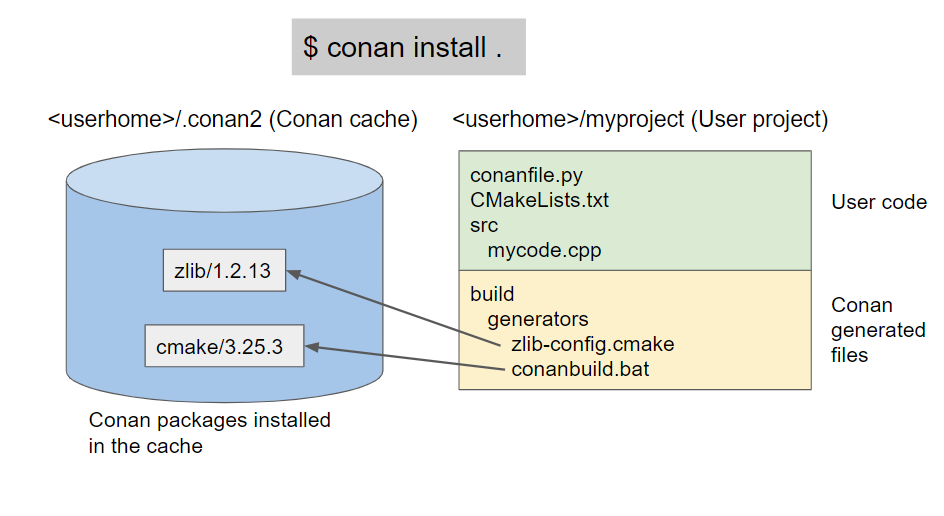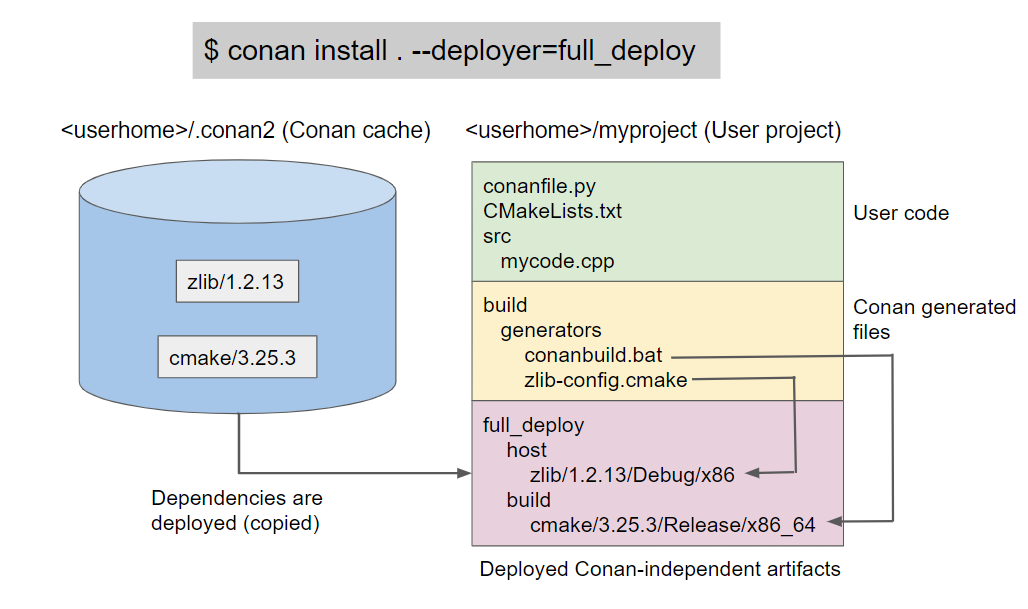Conan 2.0 implements Conan-agnostic deployment of dependencies for developers
Upgrading to a major version like 2.0 can take some effort, we know it, and we ourselves are also investing many resources to continue upgrading the packages in the ConanCenter central repository. But Conan 2.0’s new architecture and design will allow to iterate better and faster on top of it, and this is the first of many additions to Conan 2.0 to come.
This new feature allows to install Conan dependencies artifacts directly into your project folder, and achieve a fully Conan-independent project, that can be built and run even without Conan installed in the system. This has been a long time demanded feature for some cases where the normal Conan development flows are not possible.
Normal installation and usage of Conan packages
The following figure illustrates the normal usage of Conan to install and consume dependencies:

When Conan installs the dependencies, they are installed in the “Conan cache”, a folder that by default lives in the user home (Conan doesn’t need to install anything at the system level), so they can be easily used by all the projects that use those dependencies.
The Conan generated files, like the conan_toolchain.cmake or the xxx-config.cmake CMake files used to correctly locate dependencies inside the Conan cache, will contain absolute paths to the location of the headers, libraries and binaries inside the Conan cache.
The development flow is typically conan install . to install the dependencies, then a call to cmake with either generated presets or generated toolchain to build the project.
Creating a Conan-agnostic deploy of dependencies
With the Conan 2.0 new full_deploy deployer it is possible to create a Conan-agnostic copy of dependencies that can be used by developers even without having Conan installed in their computers.
Let’s see it with an example. All the source code is in the examples2.0 Github repository
$ git clone https://github.com/conan-io/examples2.git
$ cd examples2/examples/extensions/deployers/development_deploy
In that folder we can find the following conanfile.txt:
[requires]
zlib/1.2.13
[tool_requires]
cmake/3.25.3
[generators]
CMakeDeps
CMakeToolchain
[layout]
cmake_layout
The folder also contains a standard CMakeLists.txt and a main.cpp source file that can create
an executable that links with the zlib library.
We can install the Debug and Release dependencies, and deploy a local copy of the packages with:
$ conan install . --deployer=full_deploy --build=missing
$ conan install . --deployer=full_deploy -s build_type=Debug --build=missing
This will create the following folders:
├──src
├──build
│ ├──generators
| └── ZLibConfig.cmake
├──full_deploy
│ ├──build
│ │ └──cmake
│ │ └──3.25.3
│ │ └──x86_64
│ │ ├──bin
│ │
│ └──host
│ └──zlib
│ └──1.2.13
│ ├──Debug
│ │ └──x86_64
│ │ ├──include
│ │ ├──lib
│ └──Release
│ └──x86_64
│ ├──include
│ ├──lib

The project is fully self-contained. It contains both the necessary tools (like cmake executable), the headers and compiled libraries of zlib and the necessary files like ZLibConfig.cmake in the build/generators folder, that point to the binaries inside full_deploy with a relative path.
The Conan cache can be removed, and even Conan completely uninstalled, then the folder could be moved elsewhere in the computer or copied to another computer, assuming it has the same configuration of OS, compiler, etc.
$ cd ..
$ cp -R development_deploy /some/other/place
$ cd /some/other/place
And the deployed files can be used by developers:
# Commands for WINDOWS
$ cd build
# Activate the environment to use CMake 3.25
$ generators\conanbuild.bat
$ cmake --version
cmake version 3.25.3
# Configure, should match the settings used at install
# If CMake>=3.23 you can also use ``cmake --preset conan-default``
$ cmake .. -G \"Visual Studio 17 2022\" -DCMAKE_TOOLCHAIN_FILE=generators/conan_toolchain.cmake
$ cmake --build . --config Release
$ Release\compressor.exe
ZLIB VERSION: 1.2.13
Relocating environment shell files in Linux and OSX
The environment scripts in Linux and OSX are not relocatable, because they contain absolute paths and the sh shell does not have any way to provide access to the current script directory for sourced files.
This shouldn’t be a big blocker, as a “search and replace” with sed in the generators folder can fix it:
# LINUX
$ cd build/Release/generators
# Fix folders in Linux
$ sed -i 's,{old_folder},{new_folder},g' *
# Fix folders in MacOS
$ sed -i '' 's,{old_folder},{new_folder},g' *
$ source conanbuild.sh
$ cd ..
$ cmake --version
cmake version 3.25.3
# If CMake>=3.23 you can use ``cmake --preset conan-default``
$ cmake ../.. -DCMAKE_TOOLCHAIN_FILE=generators/conan_toolchain.cmake -DCMAKE_BUILD_TYPE=Release
$ cmake --build .
$ ./compressor
ZLIB VERSION: 1.2.13
Conclusions
The described new feature is not necessarily the recommended approach to consume Conan packages, but it can be useful in some exceptional cases when it is not possible to run Conan to install the dependencies for development. We are happy to be able to deliver this functionality to the users that need it with Conan 2.0.
Note that the described approach in this post is useful for 1 development configuration, as the generated CMake files can only support 1 configuration (Debug/Release for multi-config tools like Visual Studio). If you need to support multiple OSs or platforms you will need to generate 1 deploy for each one.
The presented approach can be very easily customized for your own needs, because Conan 2.0 also implement some new extensions points:
- If the
--deployer=full_deploydoesn’t implement your final desired output layout or you need to customize anything in it, it is possible to create your own deployers - For even further custom automation capabilities, check the custom commands new framework
This is a new feature and while the --deployer=full_deploy functionality works for every build system, at the moment only the CMake generated files with CMakeToolchain and CMakeDeps and the Windows environment scripts generated with VirtualBuildEnv and VirtualRunEnv are relocatable. For other build systems, it works fine if you don’t move the full_deploy folder, otherwise you might need to use the sed strategy, or consider requesting it as a new feature. Feedback is very welcome, please create a Github issue for any question, comment or suggestion about it.



